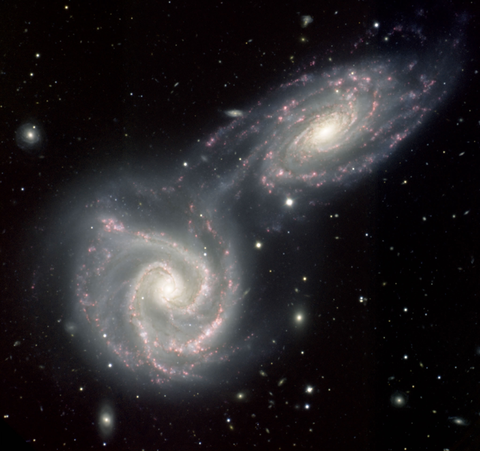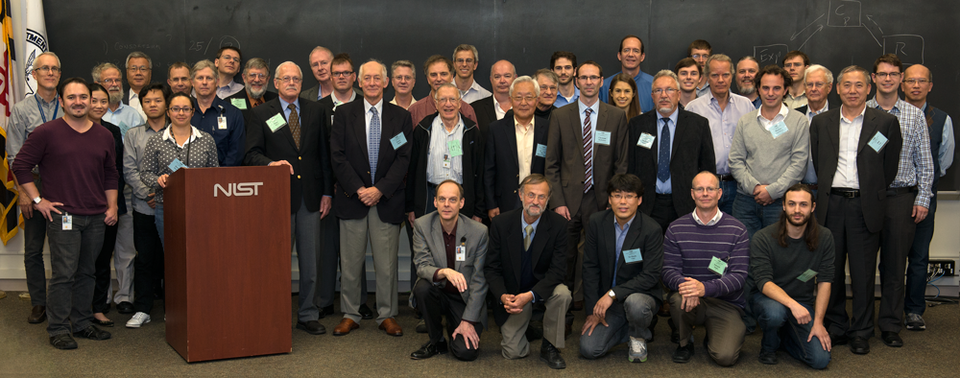
Clash of Galaxies: Measuring the gravitational constant G with greater precision could have implications for cosmology and astrophysics.
NIST has taken part in a new push to address a persistent and growing problem in physics: the value of G. The Newtonian constant of gravitation, used to calculate the attractive force of gravity between objects, is more than 300 years old. But although scientists have been trying to measure its value for centuries, G is still only known to 3 significant figures. By contrast, other constants have been measured with much greater precision; the mass of the electron in kilograms, for example, is known to about 8 digits.i
Worse yet, the more experiments researchers conduct to pin down the gravitational constant, the more their results diverge.
On October 9-10, 2014, several dozen scientists from around the world gathered at NIST to consider their options.
"We're all here because we have a problem with G – and I mean, boy, do we have a problem with G," said Carl Williams, Chief of PML's Quantum Measurement Division, to the assembled group on the first morning of the meeting. "This has become one of the serious issues that physics needs to address."
The gravitational constant is familiarly known as "big G" to distinguish it from "little g," the acceleration due to the Earth's gravity.ii Despite its name, big G is tiny – about 6.67 x 10-11 m3 kg-1 s-2 – and comparatively feeble, roughly a trillion trillion trillion times weaker than the electromagnetic force responsible for affixing souvenir magnets to refrigerators. And its weakness makes it difficult to measure.
Experimentalists have used a variety of approaches – swinging pendulums, masses in freefall, balance beams, and torsion balances that measure the torque or rotation of wires supporting masses that are attracted to other masses. But a plot of all the results from the past 15 years reveals a relatively wide spread in values ranging from about 6.670 x 10-11 m3 kg-1 s-2 to 6.676 x 10-11 m3 kg-1 s-2.
Furthermore, CODATA – the International Council for Science Committee on Data for Science and Technology, which analyzes the results of individual experiments and provides an internationally accepted sets of values for fundamental physical constants – has had to increase the uncertainty on its latest recommendation for a value of G due to the divergence of the experiments.iii
At the NIST workshop, the 53 participants agreed unanimously that something should be done. They recommended that one or more organizations establish annual or biannual meetings focused specifically on the campaign to determine big G's value with greater accuracy, and they supported the idea of focusing on new approaches to the measurement, such as the atomic interferometry setup used in a recent experiment involving laser-cooled rubidium atoms.iv

The main culprit in these discrepancies is suspected to be systematic uncertainties in the measurements, and much of the discussion focused on reducing noise. One way to address this problem, participants felt, is for different teams to conduct independent experiments using the same set of apparatus. Two groups with particularly deviant results offered their equipment during the meeting, pending discussions with the teams that will reuse the resources.
Workshop attendees expressed moderate interest in forming a consortium, an organization that would centralize the process of finding consensus. A potential benefit of a consortium would be providing NIST and other National Measurement Institutes (NMIs) with a means of contributing support, for example in the form of precision length metrology services, to members.
"Clearly, there is no right answer for how to move forward," Williams said. "But there is international support around resolving the big G controversy, and so it's a great time for us in that regard."
-- Reported and written by Jennifer Lauren Lee
i The mass of an electron is 9.109 382 91(40) x 10-31 kg, where the number in parentheses indicates uncertainty in the final two digits.
ii Calculating the gravitational attraction between two objects requires taking the product of two masses and dividing by the square of the distance between them, then multiplying that value by G. The equation is F=Gm1m2/r2.
iii CODATA's latest set, released in 2010, recommended a value for G of 6.673 84(80) x 10-11 m3 kg-1 s-2 compared to its previous result from 2006 of 6.674 28(67) x 10-11 m3 kg-1 s-2. The values in parentheses indicate standard uncertainty (based on standard deviation), in this case plus or minus 0.000 80 x 10-11 m3 kg-1 s-2 and plus or minus 0.000 67 x 10-11 m3 kg-1 s-2 respectively.
iv In this experiment, researchers pushed two clouds of cold rubidium atoms into a vacuum chamber with laser light. The atoms accelerated differently depending on the placement of high-density masses (tungsten weights totaling about 500 kg) arranged in various configurations. Differences in acceleration due to the atoms' gravitational attraction to the tungsten masses could be picked up in the clouds' interference pattern. G. Rosi, F. Sorrentino, L. Cacciapuoti, M. Prevedelli and G.M. Tino. Precision measurement of the Newtonian gravitational constant using cold atoms. Nature. Vol. 510. 518–521. June 26, 2014. DOI:10.1038/nature13433

